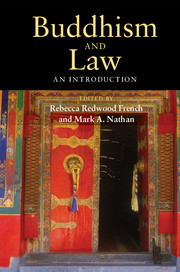Book contents
- Frontmatter
- Dedication
- Contents
- Maps and Illustrations
- Contributors
- Preface
- Abbreviations
- Introducing Buddhism and Law
- Part I The Roots of Buddhism and Law in India
- Part II Buddhism and Law in South and Southeast Asia
- Part III Buddhism and Law in East Asia
- 11 Buddhism and Law in China
- 12 The Ownership and Theft of Monastic Land in Ming China
- 13 Buddhism and Law in China
- 14 Buddhism and Law in Korean History
- 15 Buddhism and Law in Japan
- 16 Relic Theft in Medieval Japan
- Part IV Buddhism and Law in North Asia and the Himalayan Region
- A Selection of Readings
- Index
- References
11 - Buddhism and Law in China
The Emergence of Distinctive Patterns in Chinese History
Published online by Cambridge University Press: 05 August 2014
- Frontmatter
- Dedication
- Contents
- Maps and Illustrations
- Contributors
- Preface
- Abbreviations
- Introducing Buddhism and Law
- Part I The Roots of Buddhism and Law in India
- Part II Buddhism and Law in South and Southeast Asia
- Part III Buddhism and Law in East Asia
- 11 Buddhism and Law in China
- 12 The Ownership and Theft of Monastic Land in Ming China
- 13 Buddhism and Law in China
- 14 Buddhism and Law in Korean History
- 15 Buddhism and Law in Japan
- 16 Relic Theft in Medieval Japan
- Part IV Buddhism and Law in North Asia and the Himalayan Region
- A Selection of Readings
- Index
- References
Summary
King Zhao of Wei, wishing to take part in the business of his bureaucrats, announced the fact to his chief minister Lord Mengchang. “If you wish to take part in the business of your bureaucrats’ said Lord Mengchang, “why don’t you try studying law?” By the time King Zhao had read about a dozen columns of law, he was asleep. The king said: “I can’t study these laws!” Of course it’s no wonder he fell asleep – not keeping a personal grip on the handles of power and wanting to do what his underlings should have done.
This story about a king who ruled from 295–277 BCE is primarily designed to show the importance of delegation, but it also demonstrates that long before Buddhism reached China, expertise in law, already quite technical and forbidding, formed an indispensable part of the duties of a Chinese bureaucrat. Thus, even at this early stage, the Chinese theorized the nature of bureaucratic control and practiced administrative record keeping. At this point and for a couple of centuries or so after the unification of China by the First Emperor in 221 BCE, such records were written on hard materials such as slips of bamboo, but the invention of paper greatly extended the capacity of the Chinese to create written documentation. This did not prevent the first great period of empire from collapsing into an age of division and foreign invasion in much the same fashion as happened to the classical world of Europe. It did help sustain government from the late sixth century onward by a record-keeping bureaucracy into a new era of integration unparalleled in the West.
- Type
- Chapter
- Information
- Buddhism and LawAn Introduction, pp. 201 - 216Publisher: Cambridge University PressPrint publication year: 2014



